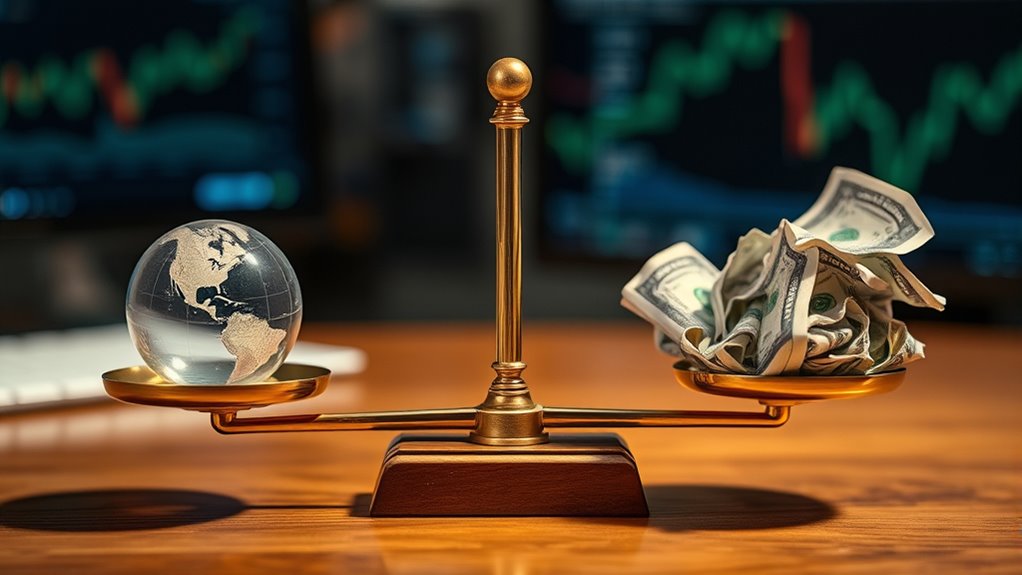Central banks fear deflation more than inflation because falling prices can trap the economy in a harmful slowdown, making it harder to grow and leading to higher unemployment. When prices drop, people and businesses delay spending, which worsens the decline. So, even though inflation isn’t ideal, deflation can cause a long-lasting slump that’s tough to reverse. If you want to understand how they fight it, this explains why their strategies matter.
Key Takeaways
- Deflation leads to reduced spending, causing economic slowdown and higher unemployment, which central banks want to avoid.
- Falling prices can trap the economy in a downward cycle, making recovery difficult.
- Deflation increases debt burdens, harming borrowers and financial stability.
- It encourages consumers to delay spending, worsening demand and economic stagnation.
- Central banks find it easier to control moderate inflation than to combat persistent deflation.

Central banks play a pivotal role in managing economic stability, especially during periods of deflation. When prices start falling, it signals a slowdown in economic activity, and that’s when central banks step in with their monetary policy tools. Their main goal is to keep inflation at a healthy level, but deflation challenges this objective by threatening to spiral the economy into a downward cycle. If prices decline persistently, consumers and businesses might delay spending, expecting prices to drop even further. This hesitation reduces demand, leading to lower profits and layoffs, which then further depress prices. It’s a vicious cycle that’s hard to break once it takes hold. Recognizing this, central banks focus on adjusting their monetary policy to counteract deflation’s effects and restore economic stability. Economic theory supports globalization and specialization, which can be disrupted during deflationary periods if prices and wages decline significantly.
To combat deflation, central banks often lower interest rates, making borrowing cheaper. This encourages individuals and companies to take out loans and spend more, injecting money into the economy. Lower interest rates also reduce the incentive to save, prompting more consumer spending, which can help lift prices. However, when rates are already near zero, central banks might resort to unconventional measures like quantitative easing—buying government bonds and other assets—to increase the money supply further. These actions aim to boost lending and investment, re-inflate prices, and prevent the economy from slipping into a deflationary trap. The challenge is that these policies take time to work and can have side effects, like asset bubbles or increased debt levels.
Your understanding of monetary policy’s role shows why central banks fear deflation more than inflation. While inflation can erode purchasing power if it gets out of control, moderate inflation is often seen as a sign of a healthy economy. On the other hand, deflation can lead to persistent stagnation, higher unemployment, and a prolonged economic downturn. Central banks worry that once deflation takes hold, it becomes difficult to reverse, as expectations of falling prices become ingrained. This makes consumers and businesses even more hesitant to spend or invest, deepening the economic decline. By carefully adjusting their monetary policy, central banks try to preempt or combat deflation early, understanding that economic stability depends on maintaining a delicate balance—avoiding both runaway inflation and damaging deflation. Recognizing the importance of expectation management is crucial, as it influences how consumers and investors respond to policy signals.
Frequently Asked Questions
How Does Deflation Impact Consumer Spending Differently Than Inflation?
When deflation occurs, you tend to become more price sensitive, delaying purchases in anticipation of lower prices. This reduction in consumer spending can slow economic growth. Additionally, if you have debt, deflation increases its real value, making it harder to repay. Unlike inflation, which can erode debt’s worth, deflation can tighten your financial situation, discouraging spending and investment, and potentially leading to a prolonged economic downturn.
Can Central Banks Effectively Combat Deflation Once It Starts?
Did you know that during the Great Depression, central banks struggled to combat 25% deflation? You might wonder if they can succeed today. Central banks use monetary tools like lowering interest rates and buying assets, but these often have limited impact once deflation takes hold. They also rely on fiscal measures—government spending and tax cuts—to boost demand. Still, fighting deflation remains challenging because of delayed effects and weak consumer confidence.
What Are the Long-Term Economic Consequences of Prolonged Deflation?
Prolonged deflation can lead to long-term economic issues like monetary stagnation, where prices and wages stay low, discouraging spending and investment. You might also face debt deflation, making existing debts more burdensome and hampering economic growth. This cycle can trap the economy in a sluggish state, reducing consumer confidence and delaying recovery, ultimately causing persistent economic stagnation that’s hard to reverse without aggressive policy intervention.
How Do Deflation Fears Influence Central Bank Policies Today?
Imagine a tightening grip that slowly freezes the economy in place. That’s how deflation fears shape your central bank’s policy responses today. They use monetary tools like lowering interest rates and quantitative easing to prevent prices from falling further. These actions aim to keep economic growth alive, but they also risk creating asset bubbles or inflation if not carefully managed. Your central bank’s goal is to maintain stability amid these delicate balancing acts.
Why Do Some Countries Experience Deflation More Frequently Than Others?
You notice some countries face deflation more often due to their economic structure and policy choices. When economies struggle, central banks may implement loose monetary policy and governments might deploy fiscal stimulus to boost demand. However, if these measures aren’t effective or are delayed, prices can fall, leading to deflation. Countries with weak fiscal responses or limited monetary policy tools are especially prone to experiencing deflation more frequently.
Conclusion
Understanding why central banks fear deflation more than inflation is like realizing that a silent storm can do more damage than a loud one. Deflation can stall economic growth and trap you in a cycle of falling prices, making it harder to recover. So, as you see prices slowly dip, remember that central banks act like vigilant sailors, steering the economy away from the quiet, lurking dangers of deflation before they become a hurricane.










